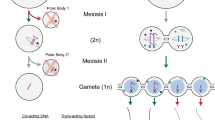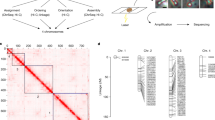Abstract
Two meiotic genes from natural populations are described. A female meiotic mutation,mei(1)g13, mapped to 17.4 on the X chromosome, causes nondisjunction of all homologs except for the fourth chromosomes. In addition, it reduces recombination by 10% in the homozygotes and causes 18% increased recombination in the heterozygotes. A male meiotic mutation,mei-1223 m144, is located on the third chromosome. Although this mutation causes nondisjunction of all chromosomes, each chromosome pair exhibits a different nondisjunction frequency. Large variations in the sizes of the premature sperm heads observed in the homozygotes may reflect irregular meiotic pairing and the subsequent abnormal segregation, resulting in aneuploid chromosome complements.
Similar content being viewed by others
References
Ashburner, M., 1989.Drosophila. A laboratory handbook. Cold Spring Harbor Lab. Press, New York.
Baker, B. S. & A. T. C. Carpenter, 1972. Genetic analysis of sex chromosomal meiotic mutants inDrosophila melanogaster. Genetics 71: 255–286.
Baker, B. S. & J. C. Hall, 1976. Meiotic mutants; genetic control of meiotic recombination and chromosome segregation, pp. 351–434 in The Genetics and Biology ofDrosophila, vol 1a, edited by M. Ashburner and E. Novitski. Academic Press, New York.
Cooper, K. W., 1964. Meiotic conjunctive elements not involving chiasmata. Proc. Nat. Acad. Sci. USA 52: 1248–1255.
Endow, S. A., S. Henikoff & L. Soler-Niedziela, 1990. Mediation of meiotic and early mitotic chromosome segregation inDrosophila by a protein related to kinesin. Nature 345: 81–83.
Gavin, J. A. & D. G. Holm, 1972. Gamma ray induced nondisjunction of chromosome 2 in females. Drosophila Inf. Service 48: 143–144.
Green, M. M., 1988. Mobile DNA elements and spontaneous gene mutation, pp. 41–50 in Eukaryotic Transposable Elements as Mutagenic Agents, edited by M. E. Lambert, J. F. McDonald and I. B. Weinstein. Cold Spring Harbor Laboratory Press, Cold Spring Harbor, N.Y.
Grell, R. F., 1976. Distributive pairing, pp. 435–486 in The Genetics and Biology ofDrosophila, vol 1a, edited by M. Ashburner and E. Novitski. Academic Press, New York.
Grell, R. F., 1984. Time of recombination in theDrosophila melanogaster oocyte. III. Selection and characterization of temperature-sensitive and -insensitive recombination-deficient alleles inDrosophila. Genetics 108: 425–443.
Hall, J. C., 1970. Non-independence of primary non-disjunction for the sex and fourth chromosomes inD. melanogaster. Drosophila Inf. Service 45: 160.
Hinton, C., 1966. Enhancement of recombination associated with c(3)G mutant ofDrosophila melanogaster. Genetics 53: 157–164.
Inoue, Y. H. & M-T. Yamamoto, 1987. Insertional DNA and spontaneous mutation at the white locus inDrosophila simulans. Mol. Gen. Genet. 209: 94–100.
Ivy, J. M., 1981. Mutations that disrupt meiosis in males ofDrosophila melanogaster. Ph. D. Thesis, University of California, San Diego.
Lindsley, D. C. & E. H. Grell, 1968. Genetic variation ofDrosophila melanogaster. Carnegie Institute of Washington, Publ 627, Washington, D.C.
Lindsley, D. C. & G. G. Zimm, 1992. The genome ofDrosophila melanogaster. Academic Press.
Mason, J. M., 1976. Orientation disruptor (ord): A recombination-defective and disjunction-defective meiotic mutant inDrosophila melanogaster. Genetics 84: 545–572.
McKee, B. D., L. Habera & A. Vrana, 1992. Evidence that intergenic spacer repeats ofDrosophila melanogaster rRNA genes function as X-Y pairing sites in male meiosis, and a general model for achiasmatic pairing. Genetics 132: 529–544.
Novitski, E., 1976. The construction of an entire compound two chromosome, pp. 562–568 in The Genetics and Biology ofDrosophila, vol 1b, edited by M. Ashburner and E. Novitski. Academic Press, New York.
Sandler, L., D. L. Lindsley, B. Nicoletti & G. Trippa, 1968. Mutants affecting meiosis in natural populations ofDrosophila melanogaster. Genetics 60: 525–558.
Smith, P. A. & R. C. King, 1969. Genetic control of synaptonemal complexes inDrosophila melanogaster. Genetics 60: 335–351.
Sturtevant, A. H., 1951. A map of the fourth chromosome ofDrosophila melanogaster, based on crossing over in triploid females. Proc Natl Acad Sci 37: 405–407.
Yamamoto, A. H. & T. Wada, 1990. A new type of mei-9 allele inDrosophila melanogaster which is recombination-competent but repair-deficient. Jpn. J. Genet. 65: 165–172.
Yamamoto, A. H., D. J. Komma, C. D. Shaffer, V. Pirrotta & S. A. Endow, 1989. The claret locus inDrosophila encodes products required for eyecolor and for meiotic chromosome segregation. EMBO J, 8: 3543–3552.
Yamamoto, M. & G. L. G. Miklos, 1977. Genetic dissection of heterochromatin inDrosophila: The role of basal X heterochromatin in meiotic sex chromosome behaviour. Chromosoma 60: 283–296.
Yamamoto, M., 1979. Cytological studies of heterochromatin function in theDrosophila melanogaster male: autosomal meiotic pairing. Chromosoma 72: 293–328.
Yamamoto, M., 1981. The mechanism of meiotic chromosome pairing in theDrosophila melanogaster male. Jpn. J. Genet. 56: 79–96.
Yamamoto, M-T., 1993. Inviability of hybrids betweenD. melanogaster andD. simulans results from the absence of simulans X not the presence of simulans Y chromosome. Genetica (in press).
Zhang, P., B. A. Knowles, L. S. Goldstein & R. S. Hawley, 1990. A kinesin-like protein required for distributive chromosome segregation inDrosophila. Cell 62: 1053–1062.
Author information
Authors and Affiliations
Rights and permissions
About this article
Cite this article
Yamamoto, A.H., Muramatsu, K., Otsuka, T. et al. Meiotic mutations from natural populations ofDrosophila melanogaster . Genetica 88, 165–173 (1993). https://doi.org/10.1007/BF02424473
Issue Date:
DOI: https://doi.org/10.1007/BF02424473




